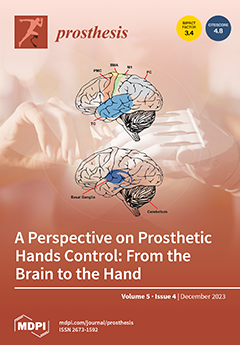Open AccessTechnical Note
Controlling a Below-the-Elbow Prosthetic Arm Using the Infinity Foot Controller
by
Peter L. Bishay, Jack Wilgus, RunRun Chen, Diego Valenzuela, Victor Medina, Calvin Tan, Taylor Ittner, Miguel Caldera, Cristina Rubalcava, Shaghik Safarian, Gerbert Funes Alfaro, Alfredo Gonzalez-Martinez, Matthew Gosparini, Jose Fuentes-Perez, Andy Lima, Jonnathan Villalobos and Abrahan Solis
Cited by 5 | Viewed by 5919
Abstract
Nowadays there are various prosthetic arm designs in the literature, the market, and CAD design websites, with different shapes, sizes, and degrees of freedom. Only limited options are available for controlling such prostheses. Prosthetic arm users reported muscle fatigue and unreliability when using
[...] Read more.
Nowadays there are various prosthetic arm designs in the literature, the market, and CAD design websites, with different shapes, sizes, and degrees of freedom. Only limited options are available for controlling such prostheses. Prosthetic arm users reported muscle fatigue and unreliability when using the market-dominated myoelectric sensors. This work presents the “Infinity Foot Controller” as a new approach to control a five-finger below-the-elbow prosthetic arm with wrist rotation and bending capabilities. This foot control system receives user input from a custom insole and a sensor-controller unit placed alongside the user’s shoe to perform various hand grips, gestures, and/or rotations. To demonstrate the new foot controller, a design of a 3D-printed below-the-elbow prosthetic arm, called the “Infinity Arm”, is presented. This arm is suitable for gripping relatively lightweight objects and making hand gestures. It includes a wrist actuation system that permits 120° wrist rotation and 70° wrist extension and flexion. It also includes a haptic feedback system that utilizes fingertip force sensors to relay a vibratory response in an armband placed on the user’s arm, giving the user a sense of touch. A proof-of-concept model was built to demonstrate the system and a testing procedure was proposed.
Full article
►▼
Show Figures





